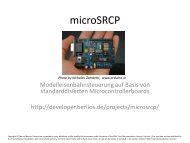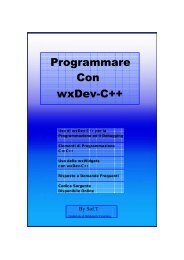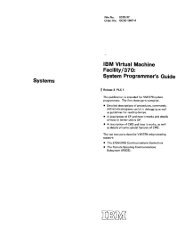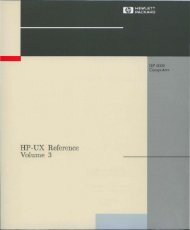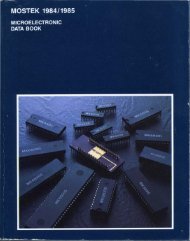Demonstration of an Aerodynamic Design Process for ...
Demonstration of an Aerodynamic Design Process for ...
Demonstration of an Aerodynamic Design Process for ...
Create successful ePaper yourself
Turn your PDF publications into a flip-book with our unique Google optimized e-Paper software.
Proceedings <strong>of</strong> ASME Turbo Expo 2010: Power <strong>for</strong> L<strong>an</strong>d, Sea <strong>an</strong>d Air<br />
Proceedings <strong>of</strong> the ASME Turbo Expo 2010: Power <strong>for</strong> L<strong>an</strong>d, Sea <strong>an</strong>dGT2010 Air<br />
June 14-18, 2010, Glasgow, GT2010UK<br />
June 14-18, 2010, Glasgow, Scotl<strong>an</strong>d<br />
DEMONSTRATION OF AN AERODYNAMIC DESIGN PROCESS FOR<br />
TURBOMACHINES USING OPEN SOURCE SOFTWARE TOOLS<br />
ABSTRACT<br />
This paper demonstrates <strong>an</strong> aerodynamic design process<br />
<strong>for</strong> turbomachines <strong>for</strong> compressible flows, using exclusively<br />
open source s<strong>of</strong>tware tools. Some relev<strong>an</strong>t s<strong>of</strong>tware already<br />
existed <strong>an</strong>d few additional components were required, which<br />
have been developed mainly by students <strong>an</strong>d are available at<br />
ftp.lfa.mw.tum.de. The geometry <strong>of</strong> turbomachine blades<br />
is described with a newly developed NURBS based blade designer.<br />
One-dimensional preliminary <strong>an</strong>alysis is done with<br />
OpenOffice.org Calc <strong>an</strong>d <strong>an</strong> extended me<strong>an</strong> line program, where<br />
loss models are already included. For two-dimensional throughflow<br />
computations a compressible streamline curvature method<br />
was implemented. Two-dimensional blade-to-blade <strong>an</strong>d threedimensional<br />
simulations are per<strong>for</strong>med with the CFD toolbox<br />
OpenFOAM. The two- <strong>an</strong>d three-dimensional results are visualized<br />
<strong>an</strong>d <strong>an</strong>alyzed using the open source postprocessing tool<br />
ParaView. The presented tools are regularly used in student<br />
projects. A generic one stage axial compressor was created with<br />
the workflow as a showcase in order to demonstrate the capabilities<br />
<strong>of</strong> the open source s<strong>of</strong>tware tools.<br />
NOMENCLATURE<br />
Latin symbols<br />
m meridional direction<br />
s chord length<br />
Oliver Borm, Balint Balassa, Sebasti<strong>an</strong> Barthmes,<br />
Julius Fellerh<strong>of</strong>f, Andreas Kührm<strong>an</strong>n, H<strong>an</strong>s-Peter Kau<br />
Institute <strong>for</strong> Flight Propulsion,<br />
Technische Universität München,<br />
Boltzm<strong>an</strong>nstr. 15<br />
D-85748 Garching, Germ<strong>an</strong>y<br />
Email: oli.borm@web.de<br />
GT2010-<br />
GT2010-22194<br />
Abbreviations<br />
CGNS CFD General Notation System<br />
CAD Computer Aided <strong>Design</strong><br />
GNU GNU’s Not Unix<br />
GUI Graphical User Interface<br />
IGES Initial Graphics Exch<strong>an</strong>ge Specification<br />
NURBS Non Uni<strong>for</strong>m Rational Basis Splines<br />
SCM Streamline Curvature Method<br />
VRML Virtual Reality Modeling L<strong>an</strong>guage<br />
VTK Visualization Toolkit<br />
INTRODUCTION<br />
In the past years open source s<strong>of</strong>tware has become more <strong>an</strong>d<br />
more import<strong>an</strong>t in m<strong>an</strong>y areas. Modern GNU/Linux distributions<br />
are able to compete with proprietary operating systems, <strong>for</strong><br />
server <strong>an</strong>d even <strong>for</strong> desktop applications. Until now it was not<br />
possible to design turbomachines exclusively with open source<br />
s<strong>of</strong>tware. In the presented work a new aerodynamic design process<br />
<strong>for</strong> turbomachines was created, using existing, or if missing,<br />
self implemented open source tools. This process covers only<br />
aerodynamical apsects <strong>an</strong>d no structural mech<strong>an</strong>ics. The general<br />
design procedure is demonstrated with a generic one stage axial<br />
compressor. The computational results <strong>of</strong> the used s<strong>of</strong>tware<br />
are partially compared with established CFD tools. An extended<br />
validation would go beyond the scope <strong>of</strong> this paper.<br />
1 Copyright © 2010 by ASME
The presented aerodynamic design process <strong>for</strong> turbomachines<br />
<strong>for</strong> compressible fluids is mainly developed <strong>an</strong>d used by<br />
students. Especially <strong>for</strong> educational purposes, open source s<strong>of</strong>tware<br />
seems to be <strong>an</strong> appropriate choice. There<strong>for</strong>e, this approach<br />
is widely used in student projects at the Institute <strong>for</strong> Flight<br />
Propulsion. This paper describes the capabilities <strong>an</strong>d the physical<br />
background <strong>of</strong> the s<strong>of</strong>tware.<br />
Utilizing open source s<strong>of</strong>tware, one benefits from the knowhow<br />
<strong>of</strong> others, which has already been implemented in a well<br />
documented way. The GNU General Public License declares the<br />
execution, m<strong>an</strong>ipulation, copying <strong>an</strong>d redistribution <strong>of</strong> the s<strong>of</strong>tware.<br />
These aspects have to be clarified in adv<strong>an</strong>ce in a multiuser<br />
development, as every student has the copyright on his own code.<br />
This paper is org<strong>an</strong>ized <strong>an</strong>alogously to the presented design<br />
process as shown in Fig. 1. The demonstration <strong>of</strong> the design process<br />
is introduced by the creation <strong>of</strong> a geometry with the Blade-<br />
<strong>Design</strong>er. Subsequently the <strong>an</strong>alysis <strong>of</strong> the blade geometry is<br />
described. The used solvers are OpenOffice, Mittel the me<strong>an</strong> line<br />
program, streamline curvature method (SCM) <strong>an</strong>d OpenFOAM.<br />
In a final step the postprocessing is depicted via ParaView <strong>an</strong>d<br />
TurboVTK. The application is demonstrated on a generic single<br />
stage axial compressor.<br />
Figure 1. DEMONSTRATED DESIGN PROCESS<br />
SOFTWARE LIBRARIES AND LANGUAGES<br />
The tools which were developed are either implemented in<br />
C++ or python under a modern GNU/Linux operating system.<br />
Hence some additional s<strong>of</strong>tware libraries are required.<br />
For the purpose <strong>of</strong> h<strong>an</strong>dling non uni<strong>for</strong>m rational basis<br />
spline (NURBS) curves <strong>an</strong>d surfaces, the NURBS++ s<strong>of</strong>tware<br />
library [1] is applied in C++. Python is a high level scripting l<strong>an</strong>guage<br />
with a large number <strong>of</strong> additional libraries, which is very<br />
easy to learn <strong>for</strong> beginning programmers. There is no python<br />
library available <strong>for</strong> h<strong>an</strong>dling NURBS curves <strong>an</strong>d surfaces with<br />
the functional r<strong>an</strong>ge <strong>of</strong> the NURBS++ library. On account <strong>of</strong> this,<br />
python bindings <strong>for</strong> the NURBS++ library have been created by<br />
Blaim <strong>an</strong>d Walter [2].<br />
CFD General Notation System (CGNS) is a widley used file<br />
<strong>for</strong>mat to store results from CFD simulations. In order to read<br />
<strong>an</strong>d write CGNS files with python <strong>an</strong> appropriate interface to the<br />
CGNS library is required. As the old pyCGNS python bindings<br />
are only working up to CGNS version 2.3, a set <strong>of</strong> new python<br />
bindings <strong>for</strong> CGNS input <strong>an</strong>d output in python has also been implemented<br />
by Walter [3].<br />
BLADE DESIGNER<br />
For the design <strong>of</strong> the turbomachine blade geometry the parametric<br />
CAD tool Blade<strong>Design</strong>er [4] has been developed by Balassa,<br />
Barthmes [5], Fellerh<strong>of</strong>f [6], Kührm<strong>an</strong>n [7] <strong>an</strong>d Walter.<br />
This tool generates a three-dimensional NURBS model from<br />
basic pr<strong>of</strong>ile parameters <strong>an</strong>d blade describing parameters. It<br />
supports multistage geometries <strong>an</strong>d provides output in IGES,<br />
VRML, blockMeshDict <strong>an</strong>d XML <strong>for</strong>mat as well as direct access<br />
to discrete points or NURBS curves <strong>an</strong>d surfaces. The project<br />
is based on a preceding work <strong>of</strong> Mögele [8] who investigated<br />
the blade modelling possibilities with NURBS surfaces. Furthermore<br />
a graphical user interface (GUI) was implemented by<br />
Walter in PyQt4, which is shown in Fig. 2.<br />
Figure 2. BLADEDESIGNER GUI<br />
2 Copyright © 2010 by ASME
Two Dimensional Pr<strong>of</strong>ile Modelling<br />
A pr<strong>of</strong>ile is defined parametrically <strong>an</strong>d without dimensions<br />
by specifying mathematical functions <strong>for</strong> the camber line <strong>an</strong>d the<br />
thickness distribution.<br />
Each camber line function is primarily specified by defining<br />
<strong>an</strong> <strong>an</strong>gle <strong>of</strong> attack <strong>an</strong>d <strong>an</strong> outflow <strong>an</strong>gle. The following alternative<br />
camber line functions are implemented:<br />
• circular arc<br />
• polynomial (degrees 2, 3, 4)<br />
• NURBS curve<br />
• NACA-65<br />
A thickness distribution has to be chosen, which will be superposed<br />
over the camber line. For the purpose <strong>of</strong> assembling<br />
this thickness distribution perpendicularly to the camber line, the<br />
local gradient <strong>an</strong>gle at each point <strong>of</strong> the camber line is calculated.<br />
Every implemented thickness distribution c<strong>an</strong> be combined with<br />
<strong>an</strong>y camber line. There are multiple methods available to create<br />
a thickness distribution:<br />
• elliptic<br />
• polynomial<br />
• NURBS curve<br />
• NACA-65<br />
A special case is the double circular arc pr<strong>of</strong>ile, which contains<br />
a circular arc camber line.<br />
All camber line functions <strong>an</strong>d thickness distributions are<br />
evaluated at discrete points. A finite difference method, in this<br />
case the iterative Tridiagonal Matrix Algorithm, is applied <strong>for</strong><br />
the purpose <strong>of</strong> distributing the discrete points in a reasonable<br />
way. For this algorithm a weighting function is required, which<br />
distributes a higher number <strong>of</strong> points to areas, where the pr<strong>of</strong>ile<br />
contour has a strong curvature. This weighting uses either directly<br />
the curvature <strong>of</strong> the thickness distribution, or is constituted<br />
by utilizing several simple mathematical functions like t<strong>an</strong>gent<br />
or arcsin. All <strong>of</strong> these operations create a narrow allocation <strong>of</strong><br />
points closely to the leading <strong>an</strong>d trailing edges while arr<strong>an</strong>ging<br />
<strong>for</strong> a wider distribution in between.<br />
For the axial compressor test case, the rotor me<strong>an</strong> line pr<strong>of</strong>ile<br />
is shown in Fig. 3. A slightly modified NACA-65-(12)10<br />
pr<strong>of</strong>ile is used. It features a more realistic small trailing edge radius<br />
instead <strong>of</strong> the sharp edge <strong>of</strong> a NACA-65 airfoil. The pr<strong>of</strong>ile<br />
Figure 3. TWO-DIMENSIONAL PROFILE<br />
is generated from a circular arc camber line <strong>an</strong>d a polynomial<br />
thickness distribution, which resembles the original NACA-65<br />
distribution very closely.<br />
Three Dimensional Blade <strong>Design</strong><br />
The three-dimensional blade modelling tr<strong>an</strong>s<strong>for</strong>ms the discrete<br />
points from the two-dimensional pr<strong>of</strong>iles to their proper position<br />
in three-dimensional space. Each blade row is defined by<br />
a set <strong>of</strong> two-dimensional pr<strong>of</strong>iles, the hub <strong>an</strong>d shroud curves <strong>an</strong>d<br />
the stagger <strong>an</strong>gle <strong>of</strong> each pr<strong>of</strong>ile. To position each pr<strong>of</strong>ile correctly,<br />
either the three-dimensional location <strong>of</strong> the blade c<strong>an</strong> be<br />
defined by the stacking line <strong>an</strong>d chord length <strong>of</strong> each pr<strong>of</strong>ile, or<br />
it c<strong>an</strong> be defined by the leading <strong>an</strong>d trailing edges <strong>of</strong> the blade.<br />
The first method is used mainly <strong>for</strong> axial machines, the second<br />
is useful <strong>for</strong> centrifugal turbomachines. The barycenter <strong>of</strong> the<br />
pr<strong>of</strong>ile is used as stacking point <strong>for</strong> the stacking line. According<br />
to this definition each pr<strong>of</strong>ile is sized, rotated <strong>an</strong>d tr<strong>an</strong>slated to<br />
its proper position in the two-dimensional m-y-space where m<br />
describes the meridional <strong>an</strong>d y the pitchwise coordinate.<br />
At this state the pr<strong>of</strong>ile geometry describes the exact <strong>an</strong>gles<br />
<strong>of</strong> the defined geometry. To keep these essential <strong>an</strong>gles, a con<strong>for</strong>mal<br />
mapping algorithm has been implemented by Barthmes [5]<br />
which is not only <strong>an</strong>gle preserving but also keeps the dimensions<br />
<strong>of</strong> the pr<strong>of</strong>ile with minimal de<strong>for</strong>mation. The results <strong>of</strong> the computation<br />
are NURBS surfaces <strong>of</strong> the blade, the camber, the hub<br />
<strong>an</strong>d the shroud. These NURBS surfaces c<strong>an</strong> be used <strong>for</strong> further<br />
data processing in order to provide direct access to the blade geometry<br />
<strong>of</strong> each blade row. At the moment the Virtual Reality<br />
Modelling L<strong>an</strong>guage (VRML) or IGES output file <strong>for</strong>mats are<br />
available.<br />
Turbomachine Definition <strong>an</strong>d Data Control<br />
If more th<strong>an</strong> one blade row is defined, the computation algorithm<br />
is repeated <strong>for</strong> each row. The Blade<strong>Design</strong>er creates a<br />
project folder structure to org<strong>an</strong>ize different computations <strong>of</strong> the<br />
turbomachine.<br />
The geometry <strong>of</strong> the generic axial compressor stage, which<br />
was generated with the Blade<strong>Design</strong>er is shown in Fig. 4. The<br />
rotor has 23 blades, while the stator consists <strong>of</strong> 29 blades. Both<br />
blade rows are designed with the a<strong>for</strong>e mentioned modified<br />
NACA-65-(12)10 pr<strong>of</strong>iles.<br />
Block Mesh Output<br />
A mesh definition file <strong>for</strong> the st<strong>an</strong>dard OpenFOAM mesh<br />
generator blockMesh c<strong>an</strong> be generated from the turbomachine<br />
geometry. For each blade row a specific blockMeshDict file is<br />
created <strong>an</strong>d consecutively processed by blockMesh in order to<br />
produce a single mesh <strong>for</strong> every blade row. For simulations with<br />
more th<strong>an</strong> one blade row it is possible to merge these single grids.<br />
3 Copyright © 2010 by ASME
Figure 4. AXIAL COMPRESSOR STAGE GEOMETRY<br />
A layer based architecture was implemented, where each<br />
mesh layer c<strong>an</strong> either be flat or a surface <strong>of</strong> revolution. If<br />
only two layers are used, a two-dimensional mesh is generated.<br />
For more th<strong>an</strong> two layers, three-dimensional grids are constructed.<br />
Based on the layer type either a linear cascade or a<br />
three-dimensional blade is created.<br />
For each mesh layer a default O10H topology has been implemented,<br />
which is plotted in Fig. 5. The pr<strong>of</strong>ile is surrounded<br />
by the O-grid which consists <strong>of</strong> six blocks. Around the O-grid<br />
ten H-blocks are positioned to complete the passage. In order to<br />
apply the cyclic boundary conditions <strong>for</strong> the one passage model<br />
in OpenFOAM, it is necessary that the vertex distribution at the<br />
upper <strong>an</strong>d lower side <strong>of</strong> the mesh is exactly the same. If this ver-<br />
Figure 5. O10H TOPOLOGY<br />
tex distribution is not exactly the same, the cyclicGgi boundary<br />
condition, with <strong>an</strong> interpolation between upper <strong>an</strong>d lower side,<br />
has to be applied.<br />
As the blockMesh tool does not support free<strong>for</strong>m surfaces,<br />
alternative open source mesh generators like gmsh [9] <strong>an</strong>d<br />
calculix-cgx [10] are under active investigation.<br />
Streamline Curvature Output<br />
To tr<strong>an</strong>sfer the geometric data from the Blade<strong>Design</strong>er to the<br />
streamline curvature method, <strong>an</strong> appropriate interface is needed<br />
between the two. The Blade<strong>Design</strong>er is implemented with<br />
such <strong>an</strong> interface, which rotates the provided three-dimensional<br />
NURBS surfaces <strong>of</strong> the turbomachine geometry into the meridi<strong>an</strong><br />
pl<strong>an</strong>e. For <strong>an</strong>y blade row the projection is divided into three<br />
blocks. Each block edge is discretized with a user defined number<br />
<strong>of</strong> points. These points <strong>for</strong>m a polyline with <strong>an</strong> optional<br />
grading in meridional <strong>an</strong>d orthogonal direction. Based on these<br />
polylines a mesh is generated utilizing the OpenFOAM mesher<br />
blockMesh <strong>an</strong>d converted back into a structured grid.<br />
The SCM requires additional geometric properties at the vertices<br />
<strong>of</strong> this grid. These properties are the axial <strong>an</strong>d radial coordinates<br />
<strong>of</strong> the vertex, the relative <strong>an</strong>gles <strong>of</strong> the current camber<br />
surface <strong>an</strong>d the blockage ratio <strong>of</strong> the blade thickness. If the camber<br />
surface is not available, it c<strong>an</strong> be computed from the blade<br />
NURBS surface recursively. The grid properties are written into<br />
<strong>an</strong> output file, along with additional input in<strong>for</strong>mation. The output<br />
file <strong>for</strong>mat is either plain text or CGNS, with partially user<br />
defined flow solution data.<br />
ONE-DIMENSIONAL ANALYSIS<br />
Two different duct flow methods are used <strong>for</strong> the preliminary<br />
one-dimensional <strong>an</strong>alysis <strong>of</strong> turbomachines.<br />
A basic me<strong>an</strong> line design <strong>of</strong> turbomachines is possible with<br />
OpenOffice.org Calc. Seven different <strong>an</strong>alytical twist distributions,<br />
which are based on the simple radial equilibrium, were<br />
integrated <strong>for</strong> axial compressors. In Tab. 1 the global input parameters<br />
<strong>for</strong> the me<strong>an</strong> line design <strong>of</strong> the generic axial compressor<br />
are listed.<br />
The st<strong>an</strong>dard fluid is air. Angles, velocities <strong>an</strong>d thermodynamic<br />
state variables are computed at five different radial <strong>an</strong>d<br />
three axial positions <strong>for</strong> each twist distribution. The final configuration<br />
uses the potential vortex swirl distribution <strong>for</strong> the simple<br />
radial equilibrium with a const<strong>an</strong>t ch<strong>an</strong>ge <strong>of</strong> total enthalpy in<br />
radial direction.<br />
For a quick preliminary <strong>an</strong>alysis <strong>an</strong> extended onedimensional<br />
me<strong>an</strong> line program <strong>for</strong> axial compressors was developed<br />
by Hüttl et al. [11]. Several loss models <strong>for</strong> different<br />
physical phenomena are included in the Mittel tool. At each axial<br />
station the flow c<strong>an</strong> be evaluated at five radial positions. A<br />
radial total enthalpy distribution <strong>an</strong>d twist distribution have to be<br />
4 Copyright © 2010 by ASME
Table 1. INPUT PARAMETERS AXIAL COMPRESSOR.<br />
Absolute Stagnation Temperature 293.15 K<br />
Absolute Stagnation Pressure 101325 Pa<br />
Absolute Inlet Machnumber 0.5 −<br />
Total Pressure Ratio 1.12 −<br />
Revolutions 8140 1<br />
min<br />
Mass Flow 12 kg<br />
s<br />
Hub-to-Tip Ratio 0.65 −<br />
Polytropic Efficency 0.88 −<br />
Degree <strong>of</strong> Reaction 0.5 −<br />
chosen from five available distributions each as boundary condition.<br />
Also a modern GUI was implemented by Walter [12] using<br />
TkInter. Either a geometry or a work load <strong>an</strong>d total pressure ratio<br />
c<strong>an</strong> be specified as input. The output then quickly delivers<br />
the other data combined with additional radial distributions <strong>of</strong><br />
<strong>an</strong>gles, velocities, state variables, pressure losses <strong>an</strong>d efficiencies.<br />
In Fig. 6 the me<strong>an</strong> line velocity tri<strong>an</strong>gles at the three axial<br />
stations <strong>of</strong> the generic axial compressor are plotted.<br />
Figure 6. MEAN LINE VELOCITY TRIANGLES (MITTEL).<br />
STREAMLINE CURVATURE METHOD<br />
In order to get more detailed in<strong>for</strong>mation about the flow distribution<br />
in the meridi<strong>an</strong> pl<strong>an</strong>e <strong>of</strong> turbomachines, a compressible<br />
streamline curvature throughflow method [13] was implemented<br />
by Borm [14], Mayer [15] <strong>an</strong>d Walter. The method is based on<br />
the theory <strong>of</strong> Lichtfuß [16] <strong>an</strong>d Happel [17]. It was successfully<br />
used with multirow axial <strong>an</strong>d centrifugal compressors.<br />
The input files have to be provided in either plain text or<br />
st<strong>an</strong>dard CGNS <strong>for</strong>mat. Both file <strong>for</strong>mats c<strong>an</strong> be generated automatically<br />
with the Blade<strong>Design</strong>er. The st<strong>an</strong>dard output file <strong>for</strong>mat<br />
is CGNS, which c<strong>an</strong> be used with several post-processing<br />
tools.<br />
The absolute stagnation temperature <strong>an</strong>d pressure are needed<br />
<strong>for</strong> input. Also the overall mass flow <strong>an</strong>d the <strong>an</strong>gular velocity in<br />
each blade row need to be specified. There is <strong>an</strong> option to apply<br />
the static pressure at the hub <strong>an</strong>d the circumferential component<br />
<strong>of</strong> the absolute velocity <strong>for</strong> each streamline at the inlet.<br />
Otherwise default initial static pressure at the hub <strong>an</strong>d a swirl<br />
free inlet condition are used. An ordinary differential equation<br />
<strong>for</strong> the static pressure is solved at each quasi-orthogonal from<br />
<strong>an</strong> initial value at the hub to the shroud. This inner iteration is<br />
repeated until the overall mass flow has converged <strong>for</strong> the quasiorthogonal.<br />
It is rerun <strong>for</strong> each quasi-orthogonal successively.<br />
There should be the same partial mass flow in each streamtube<br />
between two streamlines. Thus the streamlines are adopted to<br />
the new flow qu<strong>an</strong>tities at each quasi-orthogonal, except <strong>for</strong> the<br />
hub <strong>an</strong>d shroud streamlines. These outer iterations are continued<br />
until the positions <strong>of</strong> the streamlines are not ch<strong>an</strong>ging <strong>an</strong>ymore.<br />
The method should converge in less th<strong>an</strong> twenty outer iterations<br />
<strong>an</strong>d one minute CPU clock time on modern processors from a<br />
st<strong>an</strong>dard initial solution.<br />
The axial compressor stage was simulated with the SCM.<br />
The boundaries at the inlet were specified as mentioned in Tab. 1.<br />
The static temperature distribution <strong>of</strong> the stage is shown in Fig. 7.<br />
As the stage was designed with the potential vortex swirl distribution,<br />
there is a positive radial pressure gradient which results<br />
in a radial temperature gradient after the rotor row.<br />
Figure 7. STATIC TEMPERATURE OF THE AXIAL COMPRESSOR<br />
STAGE (SCM).<br />
5 Copyright © 2010 by ASME
OPENFOAM<br />
For two- <strong>an</strong>d three-dimensional flow simulations the CFD<br />
toolbox OpenFOAM [18] is used. OpenFOAM consists <strong>of</strong> several<br />
libraries to model steady, unsteady, compressible, incompressible,<br />
laminar <strong>an</strong>d turbulent RANS as well as LES <strong>an</strong>d other<br />
flow physics. The main adv<strong>an</strong>tage is that different libraries c<strong>an</strong><br />
be combined in the top-level solvers in order to simulate multiphysics<br />
flow.<br />
Flat Cascade Pr<strong>of</strong>ile<br />
Flat two-dimensional cascade pr<strong>of</strong>iles are simulated with the<br />
st<strong>an</strong>dard sonicFoam solver <strong>of</strong> OpenFOAM-1.6. SonicFoam<br />
is a tr<strong>an</strong>sient solver <strong>for</strong> sub- <strong>an</strong>d supersonic, laminar or turbulent<br />
flows, including RANS <strong>an</strong>d LES models. The rotor me<strong>an</strong> line<br />
pr<strong>of</strong>ile <strong>of</strong> the axial compressor is computed with this solver <strong>an</strong>d<br />
the k-Omega SST turbulence model is used. A const<strong>an</strong>t stagnation<br />
temperature, stagnation pressure <strong>an</strong>d the direction <strong>of</strong> the<br />
velocity are assumed as boundary conditions at the inlet. A const<strong>an</strong>t<br />
static pressure is applied at the outlet. Periodic boundary<br />
conditions <strong>for</strong> the upper <strong>an</strong>d lower sides, cf. Fig. 5, <strong>an</strong>d special<br />
empty boundary conditions <strong>for</strong> two-dimensional problems<br />
are used at “hub” <strong>an</strong>d “shroud”.<br />
Figure 8. MACH CONTOUR OF THE TWO-DIMENSIONAL FLAT RO-<br />
TOR PROFILE.<br />
In Fig. 8 the Mach contour values <strong>of</strong> the pl<strong>an</strong>e NACA-65<br />
rotor me<strong>an</strong> line pr<strong>of</strong>ile are plotted. The local area with higher<br />
Mach numbers is <strong>for</strong>med on the suction side as <strong>an</strong>ticipated. As<br />
expected the flow is adjacent to the geometry <strong>an</strong>d fulfills periodicity.<br />
There is only a small separation in the rear part <strong>of</strong> the<br />
pr<strong>of</strong>ile on the suction side.<br />
Linear Cascade<br />
The linear cascade is a straight<strong>for</strong>ward three-dimensional<br />
model <strong>of</strong> the flat cascade pr<strong>of</strong>ile. Thus the same solver, turbulence<br />
model <strong>an</strong>d boundary conditions at inlet, outlet <strong>an</strong>d upper<br />
as well as lower sides are used in order to simulate the linear cascade<br />
<strong>of</strong> the flat rotor me<strong>an</strong> line pr<strong>of</strong>ile. As the simulation only<br />
covers half the blade sp<strong>an</strong>, a symmetry pl<strong>an</strong>e at the “shroud” <strong>an</strong>d<br />
solid wall boundary conditions at the hub are used.<br />
The simulated linear cascade passage was repeated once in<br />
y direction <strong>an</strong>d is shown in Fig. 9. The static pressure distribution<br />
is visualized at all solid walls. Moreover four surfaces with<br />
const<strong>an</strong>t meridional coordinates are plotted with the contour <strong>of</strong><br />
the turbulent kinetic energy. In the me<strong>an</strong> surface <strong>of</strong> the cascade,<br />
which is in this simulation the top <strong>of</strong> the blade, the fluid flow is<br />
<strong>of</strong> almost two-dimensional character. Fluid <strong>of</strong> a higher turbulent<br />
kinetic energy is concentrated in the corner <strong>of</strong> the blade suction<br />
side <strong>an</strong>d hub. This fluid is convected downstream the blade <strong>an</strong>d<br />
mixed out. The vertical streamlines are separated slightly from<br />
the hub in the direction towards the me<strong>an</strong> surface at approximately<br />
80% <strong>of</strong> the suction side, exactly where the fluid with the<br />
high turbulent kinetic energy accumulates.<br />
S1 Surface<br />
For the simulation <strong>of</strong> rotating blade rows some additional<br />
models were needed. The SRFZones library was implemented<br />
Figure 9. STATIC PRESSURE AT THE SOLID WALLS OF THE LINEAR<br />
CASCADE.<br />
6 Copyright © 2010 by ASME
[19] in order to compute additional fictitious <strong>for</strong>ces in the relative<br />
coordinate systems within multiple zones. The coriolis <strong>an</strong>d<br />
centrifugal <strong>for</strong>ces <strong>for</strong> the momentum equation <strong>an</strong>d the centrifugal<br />
<strong>for</strong>ce <strong>for</strong> the energy equation are evaluated in each cell. This<br />
library is used in the sonicSRFFoam solver, which is basically<br />
derived from the st<strong>an</strong>dard sonicFoam solver in order to compute<br />
the relative velocity in relative coordinate systems.<br />
The sonicSRFFoam solver is used <strong>for</strong> the computation <strong>of</strong><br />
the me<strong>an</strong> line pr<strong>of</strong>ile <strong>of</strong> the axial compressor rotor at the twodimensional<br />
S1 surface. This type <strong>of</strong> simulation c<strong>an</strong> be either<br />
used separately <strong>for</strong> blade-to-blade simulations or in conjunction<br />
with a streamline curvature method <strong>for</strong> the evaluation <strong>of</strong> the entropy<br />
rise. The absolute stagnation temperature, the absolute<br />
stagnation pressure <strong>an</strong>d the direction <strong>of</strong> the absolute velocity in<br />
cylindrical coordinates are set as boundary conditions at the inlet.<br />
A const<strong>an</strong>t static pressure is used at the outlet. A matching periodic<br />
boundary condition is applied at the pitchwise sides. The<br />
“hub” <strong>an</strong>d “shroud” boundaries are <strong>of</strong> type symmetry pl<strong>an</strong>e.<br />
For solving the relative velocity in rotating coordinate systems,<br />
some appropriate boundary conditions are necessary. As<br />
a result a boundary condition was implemented [19] <strong>for</strong> the purpose<br />
<strong>of</strong> computing the static temperature in a relative coordinate<br />
system from the specified absolute stagnation temperature <strong>an</strong>d<br />
the relative <strong>an</strong>d <strong>an</strong>gular velocity at each specified cell. In addition<br />
a boundary condition was developed to convert the defined<br />
direction <strong>of</strong> the absolute velocity into the direction <strong>of</strong> the relative<br />
velocity in either cartesi<strong>an</strong> or cylindrical coordinates.<br />
As only one blade passage was simulated, it was repeated<br />
in pitchwise direction <strong>for</strong> a better visualization <strong>of</strong> the flow.<br />
The magnitude <strong>of</strong> the relative velocity distribution is plotted in<br />
Fig. 10. There is a local area in front <strong>of</strong> the the leading edge with<br />
a low magnitude <strong>of</strong> the relative velocity. The high velocity field<br />
at the suction side <strong>of</strong> the pr<strong>of</strong>ile decreases towards the pressure<br />
side <strong>of</strong> the pr<strong>of</strong>ile due to the periodic boundary conditions. The<br />
incidence at the leading edge seems to converge to zero.<br />
Single Rotor<br />
A straight<strong>for</strong>ward extension <strong>of</strong> the computation <strong>of</strong> S1 surface<br />
flows is the single rotor computation. All the a<strong>for</strong>e mentioned<br />
methods c<strong>an</strong> be used <strong>an</strong>alogously. If the rotor stator interface<br />
is not coincident with geometrical gaps at a boundary wall,<br />
like at hub <strong>an</strong>d shroud, this boundary patch has two different absolute<br />
velocities. There<strong>for</strong>e, <strong>an</strong> additional boundary condition,<br />
in which two different <strong>an</strong>gular velocities <strong>for</strong> a boundary patch<br />
are defined, was introduced [19]. In order to cut the boundary<br />
patch into two regions with the two different <strong>an</strong>gular velocities,<br />
a bounding box in the meridi<strong>an</strong> pl<strong>an</strong>e has to be specified. Thus<br />
all cell centers <strong>of</strong> the boundary patch that are inside the bounding<br />
box are associated with the second specified <strong>an</strong>gular velocity,<br />
<strong>an</strong>d all other cell centers outside the bounding box use the first<br />
<strong>an</strong>gular velocity.<br />
Figure 10. MAGNITUDE OF THE RELATIVE VELOCITY AT THE RO-<br />
TOR MIDSPAN S1 SURFACE.<br />
The rotor <strong>of</strong> the axial compressor was simulated with the<br />
sonicSRFFoam solver. The boundary conditions are identical<br />
to the ones used in the S1 surface computation, except <strong>for</strong> the<br />
ones at the hub <strong>an</strong>d the shroud patches. For these patches the<br />
above mentioned boundary condition was used. The mesh has<br />
approximately 160k cells <strong>an</strong>d was generated with the blockMesh<br />
Output <strong>of</strong> the Blade<strong>Design</strong>er.<br />
In Fig. 11 the temperature distribution is shown at the solid<br />
wall boundary patches. Moreover surface streamlines at the solid<br />
wall boundaries are visualized with the shear stress vector. The<br />
fluid flow seems to have <strong>an</strong> almost two-dimensional topology.<br />
No serious three-dimensional flow effects are visible.<br />
For comparison reasons the geometry <strong>of</strong> the generic axial<br />
compressor rotor was also simulated with Numeca/Fine Turbo.<br />
The boundary conditions are identical to the ones <strong>of</strong> the Open-<br />
FOAM simulation <strong>an</strong>d the number <strong>of</strong> cells are similar. Nevertheless,<br />
the mesh topologies differ <strong>an</strong>d a comparison between these<br />
two solvers is strongly rough. This task should only serve as <strong>an</strong><br />
indication to validate the OpenFOAM solutions.<br />
Table 2. COMPARISON OF GLOBAL PARAMETERS.<br />
Flow Qu<strong>an</strong>tity OpenFOAM Fine Turbo Difference<br />
θtt 1.0294 − 1.0314 − -0.1980 %<br />
Πtt 1.1047 − 1.1077 − -0.3055 %<br />
˙m 12.719 kg<br />
s<br />
12.699 kg<br />
s<br />
1.9469 %<br />
7 Copyright © 2010 by ASME
In Tab. 2 global parameters are compared between the two<br />
simulations. The static temperature <strong>an</strong>d the components <strong>of</strong><br />
the absolute velocity are averaged with mass flow weighting at<br />
the outlet, whereas the static pressure is averaged with <strong>an</strong> area<br />
weighting. The absolute total temperature ratio θtt <strong>an</strong>d the absolute<br />
total pressure ratio Πtt are computed with these averaged<br />
variables. Furthermore, the mass flux is integrated at the outlet.<br />
The global parameters from both simulations are quite similar,<br />
underlining the capability <strong>of</strong> the open source s<strong>of</strong>tware.<br />
Figure 11. STATIC TEMPERATURE AT THE SOLID WALLS OF THE<br />
ROTOR WITH SURFACE STREAMLINES.<br />
Some preliminary work at steady (mixing pl<strong>an</strong>e) <strong>an</strong>d unsteady<br />
(domain scaling) rotor stator interfaces <strong>for</strong> incompressible<br />
flows has been done by Blaim [20]. Newly developed rotor stator<br />
interfaces are available in OpenFOAM. But due to time limitations<br />
these mixing pl<strong>an</strong>e <strong>an</strong>d domain scaling interfaces have not<br />
yet been tested.<br />
POSTPROCESSING<br />
The post processing is carried out with the open source, scalable,<br />
multi-plat<strong>for</strong>m data <strong>an</strong>alysis <strong>an</strong>d visualization application<br />
ParaView [21]. ParaView is based on the Visualization Toolkit<br />
(VTK). It is designed <strong>for</strong> visualization <strong>of</strong> large data sets <strong>an</strong>d has<br />
been used with up to 6 billion cells in structured grids. It is able to<br />
run in parallel mode on multiple-processor distributed-memory<br />
supercomputers. In order to <strong>an</strong>alyze turbomachines some additional<br />
tools like TurboVTK [22] were implemented in python<br />
using VTK bindings.<br />
Dimensionless Meridional <strong>an</strong>d Sp<strong>an</strong>wise Coordinates<br />
For each blade row dimensionless meridional <strong>an</strong>d sp<strong>an</strong>wise<br />
coordinates are computed with a linear tr<strong>an</strong>sfinite interpolation.<br />
Thus a background mesh is created in the meridi<strong>an</strong> pl<strong>an</strong>e with<br />
four boundary curves (hub, inlet, shroud, outlet). The boundary<br />
curves have to be provided either from the geometry modelling<br />
system or c<strong>an</strong> be extracted from the boundary patches inside<br />
ParaView. The values <strong>of</strong> the meridional <strong>an</strong>d sp<strong>an</strong>wise coordinates<br />
<strong>of</strong> the background mesh are interpolated onto the threedimensional<br />
grid points. With these values it is possible to create<br />
iso surfaces <strong>of</strong> const<strong>an</strong>t sp<strong>an</strong>wise <strong>an</strong>d meridional coordinates<br />
from the three-dimensional mesh.<br />
The boundary curves <strong>of</strong> the axial rotor in the meridi<strong>an</strong> pl<strong>an</strong>e<br />
are prepared with the Blade<strong>Design</strong>er. The dimensionless sp<strong>an</strong>wise<br />
<strong>an</strong>d meridional coordinates are generated <strong>for</strong> the whole rotor<br />
mesh as described above. In Fig. 12 the distribution <strong>of</strong> the<br />
relative Mach number is shown at such a const<strong>an</strong>t sp<strong>an</strong>wise coordinate.<br />
For <strong>an</strong> axial turbomachine this geometric S1 surface is<br />
identical to a surface with a const<strong>an</strong>t radius. The computation<br />
<strong>of</strong> the coordinates c<strong>an</strong> be accomplished either within <strong>an</strong> external<br />
python script or inside the ParaView GUI with the Programmable<br />
filter.<br />
Con<strong>for</strong>mal Mapping <strong>of</strong> S1 Surfaces<br />
To visualize <strong>an</strong>d <strong>an</strong>alyze the flow on S1 surfaces, a common<br />
approach is to flatten the three-dimensional surface into two<br />
dimensions. An <strong>an</strong>gle-preserving algorithm <strong>for</strong> con<strong>for</strong>mal mapping<br />
based on fundamental nets has been developed <strong>an</strong>d imple-<br />
Figure 12. MAGNITUDE OF THE RELATIVE MACH NUMBER AT THE<br />
ROTOR MIDSPAN S1 SURFACE.<br />
8 Copyright © 2010 by ASME
mented. This tool extracts <strong>an</strong> S1 surface at a specified sp<strong>an</strong>wise<br />
coordinate from a three-dimensional mesh with given dimensionless<br />
meridional <strong>an</strong>d sp<strong>an</strong>wise coordinates. Each point <strong>of</strong> this surface<br />
is tr<strong>an</strong>s<strong>for</strong>med con<strong>for</strong>mally to the two-dimensional pl<strong>an</strong>e.<br />
This algorithm c<strong>an</strong> be applied either directly in a python script or<br />
via the ParaView GUI within a Programmable filter.<br />
An S1 surface at 50% dimensionless sp<strong>an</strong>width coordinate<br />
is extracted from the rotor mesh <strong>of</strong> the axial compressor <strong>an</strong>d<br />
mapped in two dimensions. This is done with the results <strong>of</strong> the<br />
Fine Turbo computation within TurboVTK <strong>an</strong>d Numeca/CFView<br />
in order to compare both implementations. The results <strong>for</strong> the<br />
magnitude <strong>of</strong> the relative velocity distribution at this sp<strong>an</strong>wise<br />
coordinate are quite similar, as shown in Fig. 13. Furthermore,<br />
this c<strong>an</strong> be compared with the two-dimensional OpenFOAM<br />
simulation in Fig. 10.<br />
Figure 13. MAGNITUDE OF THE RELATIVE VELOCITY AT THE<br />
ROTOR MIDSPAN S1 SURFACE (CONFORMAL TWO-DIMENSIONAL<br />
VIEW).<br />
Pitchwise Averaging<br />
For the purpose <strong>of</strong> visualizing the flow distribution in the<br />
meridi<strong>an</strong> pl<strong>an</strong>e from three-dimensional simulations, a pitchwise<br />
averaging is per<strong>for</strong>med. Thus each specified flow qu<strong>an</strong>tity which<br />
is available at each grid point <strong>of</strong> the three-dimensional mesh c<strong>an</strong><br />
be averaged either area or mass flow weighted. For each dimensionless<br />
meridional coordinate from the background mesh<br />
a const<strong>an</strong>t meridional surface inside the three-dimensional mesh<br />
is created. Moreover this const<strong>an</strong>t meridional surface is divided<br />
<strong>for</strong> each grid point <strong>of</strong> the background mesh into a stripe in sp<strong>an</strong>wise<br />
direction. For each stripe <strong>an</strong> averaged value <strong>for</strong> each desired<br />
flow qu<strong>an</strong>tity is computed. These values are stored at the associated<br />
grid point <strong>of</strong> the background mesh. This algorithm c<strong>an</strong> be<br />
used inside the ParaView GUI in the Programmable filter or in<br />
<strong>an</strong> external python script.<br />
The result <strong>of</strong> the single rotor computation from Fine Turbo<br />
was used in order to compare the pitchwise averaging between<br />
TurboVTK <strong>an</strong>d CFView. In Fig. 14 the pitchwise mass flow<br />
weighted average static temperature is plotted. There are only<br />
minor differences, which may result from different background<br />
meshes. In addition the pitchwise averaged static temperature<br />
c<strong>an</strong> be compared with the result from the streamline curvature<br />
method in Fig. 7.<br />
Figure 14. PITCHWISE MASSFLOW WEIGHTED AVERAGE STATIC<br />
TEMPERATURE OF THE ROTOR.<br />
9 Copyright © 2010 by ASME
Due to the thickness <strong>of</strong> the rotor blade <strong>an</strong> acceleration <strong>of</strong><br />
the axial velocity takes place, resulting in a decrease <strong>of</strong> the static<br />
temperature inside the rotor blade passage. The relative deceleration<br />
<strong>of</strong> the flow in the compressor rotor causes <strong>an</strong> overall static<br />
temperature rise at the outlet compared to the inlet.<br />
Turbo Calculator<br />
An array calculator to compute additional flow qu<strong>an</strong>tities in<br />
ParaView is available. Nevertheless, it is <strong>an</strong>noying <strong>an</strong>d errorprone<br />
to type the <strong>for</strong>mula <strong>for</strong> each flow qu<strong>an</strong>tity into the array<br />
calculator. On account <strong>of</strong> this a python based Programmable filter<br />
was written <strong>for</strong> the purpose <strong>of</strong> computing specified additional<br />
flow qu<strong>an</strong>tities like absolute <strong>an</strong>d relative stagnation flow qu<strong>an</strong>tities,<br />
velocities in cylindrical coordinates, entropy <strong>an</strong>d Mach<br />
number among others. This tool is not restricted to OpenFOAM<br />
cases <strong>an</strong>d c<strong>an</strong> there<strong>for</strong>e easily be extended to other flow solvers.<br />
Only the names <strong>of</strong> the input variables have to be adjusted accordingly.<br />
Beyond that it is possible to calculate scalar, vector <strong>an</strong>d tensor<br />
gradients with the Compute Derivatives filter in order to get<br />
the vorticity or strain <strong>of</strong> flow qu<strong>an</strong>tities <strong>for</strong> example.<br />
CONCLUSION<br />
A new aerodynamic design process <strong>for</strong> compressible turbomachines<br />
using open source s<strong>of</strong>tware tools has been developed<br />
<strong>an</strong>d described. The functionality <strong>of</strong> the whole design process was<br />
successfully demonstrated with a single stage axial compressor.<br />
A new blade designer was implemented in order to describe the<br />
blade geometry in a parametric way <strong>for</strong> multiple axial <strong>an</strong>d radial<br />
blade rows. Furthermore, the geometric input <strong>for</strong> a streamline<br />
curvature method <strong>an</strong>d OpenFOAM c<strong>an</strong> be generated automatically.<br />
Tools <strong>for</strong> one-, two- <strong>an</strong>d three-dimensional flow <strong>an</strong>alysis<br />
were presented. The postprocessing <strong>of</strong> the two- <strong>an</strong>d threedimensional<br />
results is accomplished with ParaView. These s<strong>of</strong>tware<br />
tools have already proven very useful <strong>for</strong> the education <strong>of</strong><br />
students.<br />
Future development will aim <strong>for</strong> the implementation <strong>of</strong> rotor<br />
stator interfaces in OpenFOAM. Moreover the s<strong>of</strong>tware tools<br />
will be further validated <strong>an</strong>d verified via well known measurements<br />
<strong>an</strong>d established CFD codes. In addition to that a compressible<br />
multi physics solver <strong>for</strong> coupled Fluid-Structure-Interaction<br />
in turbomachines is pl<strong>an</strong>ned. Additionally the design process<br />
could also be coupled with optimization techniques like Genetic<br />
Algorithms <strong>for</strong> inst<strong>an</strong>ce Eva2 [23] <strong>an</strong>d Neuronal Networks like<br />
SNNS [24].<br />
ACKNOWLEDGMENT<br />
Special th<strong>an</strong>ks go to Herbert Mögele <strong>for</strong> the first version <strong>of</strong><br />
the Blade<strong>Design</strong>er [8] <strong>an</strong>d Steve Walter <strong>for</strong> his work on several<br />
subprojects [2, 3, 4, 12, 13]. Furthermore, special th<strong>an</strong>ks go to<br />
Fr<strong>an</strong>z Blaim <strong>for</strong> the preliminary work on rotor stator interfaces<br />
in OpenFOAM [20].<br />
REFERENCES<br />
[1] NURBS++, 2002. Version 3.0.11. http://libnurbs.<br />
source<strong>for</strong>ge.net.<br />
[2] PythonNURBS, 2009. Version 0.3. http://pypi.<br />
python.org/pypi/PythonNURBS.<br />
[3] PythonCGNS, 2009. Version 2009.10.30. http://<br />
pypi.python.org/pypi/CGNS.<br />
[4] Blade<strong>Design</strong>er, 2009. Version 2009.09.22.<br />
ftp://ftp.lfa.mw.tum.de/pub/S<strong>of</strong>tware/<br />
bladedesigner.<br />
[5] Barthmes, S., 2010. “Entwicklung eines parametrischen<br />
CAD-Systems für Turbomaschinen”. Semester thesis,<br />
Institute <strong>for</strong> Flight Propulsion, Technische Universität<br />
München.<br />
[6] Fellerh<strong>of</strong>f, J., 2010. “Entwicklung eines parametrischen<br />
Pr<strong>of</strong>ilgenerators zur Beschreibung von 2-D Pr<strong>of</strong>ilschnitten<br />
in Turbomaschinenbeschaufelungen”. Semester thesis,<br />
Institute <strong>for</strong> Flight Propulsion, Technische Universität<br />
München.<br />
[7] Kührm<strong>an</strong>n, A., 2010. “Entwicklung eines Programms<br />
zur parametrischen Generierung von OpenFOAM Netzdefinitionsdateien<br />
für Turbomaschinenbeschaufelungen”.<br />
Semester thesis, Institute <strong>for</strong> Flight Propulsion, Technische<br />
Universität München.<br />
[8] Mögele, H., 2006. “Parametrische Geometriedefinition<br />
von Turbomaschinenbeschaufelungen”. Semester thesis,<br />
Institute <strong>for</strong> Flight Propulsion, Technische Universität<br />
München.<br />
[9] gmsh, 2009. Version 2.4.2. http://www.geuz.org/<br />
gmsh.<br />
[10] calculix-cgx, 2009. Version 2.0. http://www.<br />
dhondt.de.<br />
[11] Hüttl, T., 1994. “Zur EDV-gemäßen Darstellung von Axial-<br />
Turboverdichter-Auslegungen auf der Basis eines erweiterten<br />
Mittelschnittsverfahren”. Diploma thesis, Institute<br />
<strong>for</strong> Flight Propulsion, Technische Universität München.<br />
[12] Mittel, 2009. Version 2009.04.16. ftp://ftp.lfa.<br />
mw.tum.de/pub/S<strong>of</strong>tware/mittel.<br />
[13] skv, 2010. Version 0.0.4. ftp://ftp.lfa.mw.tum.<br />
de/pub/S<strong>of</strong>tware/skv.<br />
[14] Borm, O., 2006. “Entwicklung eines Stromlinienkrümmungsverfahrens”.<br />
Semester thesis, Institute <strong>for</strong> Flight<br />
Propulsion, Technische Universität München.<br />
[15] Mayer, F., 2008. “Entwicklung eines Stromlinienkrümmungsverfahrens<br />
für die Turboladervorentwicklung”.<br />
Diploma thesis, Institute <strong>for</strong> Flight Propulsion, Technische<br />
Universität München.<br />
10 Copyright © 2010 by ASME
[16] Lichtfuß, H.-J., WS 2005/06. Anwendung strömungsmech<strong>an</strong>ischer<br />
Berechnungsverfahren in Flugtriebwerken. Technische<br />
Universität München. Lecture Notes.<br />
[17] Happel, H.-W., WS 2007/08. Rechenverfahren zur<br />
Turbomaschinenauslegung. Universität der Bundeswehr<br />
München. Lecture Notes.<br />
[18] OpenFOAM, 2009. Version 1.6. http://www.<br />
openfoam.com.<br />
[19] Borm, O., 2009. Contributions to the OpenFOAM SIG<br />
TurboMachinery. Version 1.6.<br />
http://openfoam-extend.svn.source<strong>for</strong>ge.<br />
net/viewvc/openfoam-extend/trunk/<br />
Breeder_1.6/OSIG/TurboMachinery.<br />
[20] Blaim, F., 2008. “Implementation <strong>of</strong> Rotor Stator Interfaces<br />
<strong>for</strong> the Open Field Operation <strong>an</strong>d M<strong>an</strong>ipulation (Open-<br />
FOAM) CFD Toolbox”. Diploma thesis, Institute <strong>for</strong> Flight<br />
Propulsion, Technische Universität München.<br />
[21] ParaView, 2009. Version 3.6.1. http://www.<br />
paraview.org.<br />
[22] TurboVTK, 2009. Version 2009.11.15. ftp://ftp.<br />
lfa.mw.tum.de/pub/S<strong>of</strong>tware/turbovtk.<br />
[23] EvA2, 2010. Version 2.043. http://www.ra.cs.<br />
uni-tuebingen.de/s<strong>of</strong>tware/EvA2.<br />
[24] SNNS, 2008. Version 4.3. http://www.ra.cs.<br />
uni-tuebingen.de/s<strong>of</strong>tware/snns.<br />
11 Copyright © 2010 by ASME



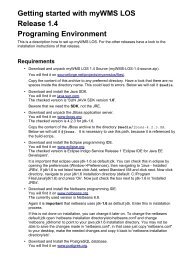
![04. The Da Vinci Code - Dan Brown(2003)[dobd.tk].pdf](https://img.yumpu.com/17290229/1/190x245/04-the-da-vinci-code-dan-brown2003dobdtkpdf.jpg?quality=85)
